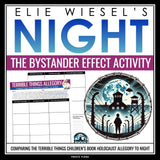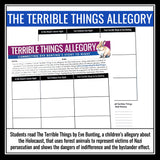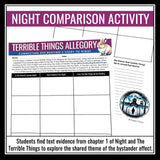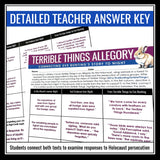Night by Elie Wiesel Activity - Terrible Things Holocaust Allegory Assignment
Night by Elie Wiesel Activity - Terrible Things Holocaust Allegory Assignment: Use Eve Bunting’s powerful children’s book The Terrible Things as an allegory to help students better understand key themes in Night by Elie Wiesel. This creative and accessible activity allows students to examine how both texts explore responses to injustice, denial, scapegoating, and silence during the Holocaust. Through guided text-to-text connections and theme analysis, students gain a deeper appreciation for the moral and emotional impact of Wiesel’s memoir. This activity is intended to be used after students have read the first chapter of Night by Elie Wiesel.
This is included in a unit plan:
>>> Night by Elie Wiesel Unit Plan
Included in The Terrible Things & Night by Elie Wiesel Allegory Resource:
➡️ The Terrible Things Video Link to Read-Aloud: A link to a video read-aloud of Terrible Things is included, allowing students to experience the children’s story visually.
➡️ Text-to-Text Connection Chart: Students complete a side-by-side comparison chart that guides them in identifying parallel events and ideas from Night and Terrible Things. For each moment from Night by Elie Wiesel, students provide text evidence and link it to a comparable scene or quote from Bunting’s allegory.
➡️ Theme Writing Response: After completing the comparison chart, students respond to a writing prompt that asks them to identify and explain a shared theme between the two texts. A sample answer key is provided.
How the Terrible Things & Night by Elie Wiesel Allegory Resource Works:
- Begin by showing the read-aloud video of Terrible Things to introduce the allegory in an engaging and accessible way.
- Assign the first section of Night and provide students with the text-to-text comparison chart.
- Guide students in identifying key moments from Night by Elie Wiesel and connecting them to scenes in The Terrible Things using textual evidence.
- Have students complete the final writing task, analyzing a shared theme (such as silence, scapegoating, or denial) and explaining how each text conveys it.
© Presto Plans
➡️ Want 10 free ELA resources sent to your inbox? Click here!








